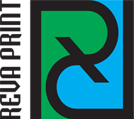All-over UV varnish (thin layer of varnish)
NB! We have ready for use gloss, matt and gloss varnish for hot stamping in the stock.
The technical specifications of the machine state that there may be problems below 130 g/m2.
We have experience with applying varnish on 60 gram paper, but there is a possibility that the machine will crease the paper.
It is only possible to use covered gloss paper.
Silk finish matte paper absorbs the varnish (in some cases offset varnish has helped).
Inks
The inks must be suitable for UV varnishing – it means that they must not contain wax or only very little.
The printed matter must be sufficiently dry for varnishing.
According to the varnish producer the sheets should dry for 24-72 hours before the actual varnishing depending on the room temperature and humidity.
The drying time is considerably longer in a cooler room.
Drying time is particularly important in case of metallic colours and large full surfaces.
It has happened that a thick layer of golden or silver paint which has seemed dry comes off after varnishing with the part that had in fact dried.
There may be problems with metallic and fluorescent colours and with reflexive blue.
In case of metallic and fluorescent colours the thickness of the coat of paint is very important.
As fluorescent colours contain a lot of pigment, the varnish may be absorbed by the paint and as a result the surface might be uneven and sticky.
A longer drying period might help to some extent.
UV varnish might change the colouring (the paints which contain the reflexive blue pigment).
Printing powder
The amount and the size of grain of the printing powder need to be monitored.
Our machine will collect some of the powder but not all.
A larger amount of powder which remains on the sheet will result in matte patches in the varnish.
Large grain powder will cause the surface of the varnish to remain uneven.
If there is a lot of excessive powder left on the sheets and our machine is unable to remove all of it, there have been cases in which the printed matter goes through the printing machine again.

